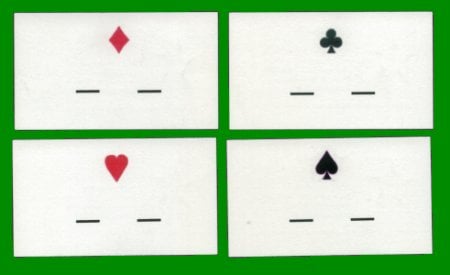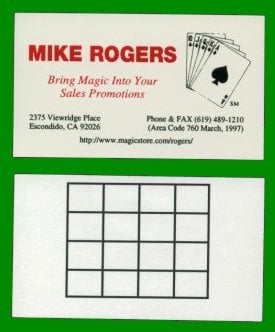|
by Mike Rogers
For many years I have presented a Magic Square in various ways, mostly using it on client company literature. I have also used it in a card counting demonstration during a gambling routine if you can believe that. The Square I use is from the Allerton book and is quite common. It works best using a number between 20 and 100. It will actually work with any number, but using a number below 20 requires the use of negative numbers, and using a number above 100 becomes cumbersome. Hence, between 20 and 100 is best. It is not good to ask for a number in that range because it’s obvious there is some control. It’s best if there appears to be no control. Here’s how I do it. Draw the 16 block empty square. Beside that draw a lopsided oval. Ask spectator A to name a number between one and ten. If he names a low number such as a 3 that’s great. Write it in the LEFT side of the oval. Ask spectator B to name a number between one and ten. What ever he names write it to the RIGHT of the 3. Hence, the number is in the 30s which looks great once you subtract 20 to get to the key. If, however, Spectator A names a high number such as an 8, write it to the RIGHT side of the oval. Whatever Spectator B names goes to the LEFT. Normally you can contrive to get the lowest number from the two named. For instance let’s assume the two numbers named are 3 and 9. That could be a 93, or a 39. Naturally the square will look better with the lower number. By using a lopsided oval the position of the numbers within the oval will not be questioned as you simply make it appear that you are just fitting them in any haphazard spot. At times they will both name high digit. When that happens just take your lumps and use them anyway.
After the number has been established do the Magic Square as described in several books.
Let’s move on to the strongest handling I’ve come across. This sends them away talking to themselves. I call it: (Credit many with the methods, credit me for the presentation angle.)
NUMEROLOGY HOAX (So named because it has nothing to do with Numerology, but they think it does).
Effect:
 Four business cards are shown. On the back of each is a Diamond pip, a Club pip, a Heart pip, and a Spade pip. Not all four on each card, but a different one on each card. Additionally, below the pip are two horizontal lines side by side , each about 1/4 inch long. Performer turns his back and gives all instructions with back turned. Spectator is invited to select one of the pips, then gather the other three cards together turning them pip side down in a stack to prevent the performer from knowing which is which. The spectator is then instructed to write a single digit on either one of the horizontal lines, a digit between 1 and 10, not 1 and not 10, but between 1 and 10 (wording is important). Once done he is given the same instructions for the other horizontal line, a digit between 1 and 10, not 1 and not 10. This card is then placed on the table pip side down. Four business cards are shown. On the back of each is a Diamond pip, a Club pip, a Heart pip, and a Spade pip. Not all four on each card, but a different one on each card. Additionally, below the pip are two horizontal lines side by side , each about 1/4 inch long. Performer turns his back and gives all instructions with back turned. Spectator is invited to select one of the pips, then gather the other three cards together turning them pip side down in a stack to prevent the performer from knowing which is which. The spectator is then instructed to write a single digit on either one of the horizontal lines, a digit between 1 and 10, not 1 and not 10, but between 1 and 10 (wording is important). Once done he is given the same instructions for the other horizontal line, a digit between 1 and 10, not 1 and not 10. This card is then placed on the table pip side down.
Performer turns towards spectator and then places all four cards in a business card case/wallet without looking at them.

|
A cold reading of sorts is then given finally naming the selected pip. Another business card is introduced, this card having the 16 block empty square already imprinted on the back. The performer tells the spectator that the digits he wrote side by side make a new two digit number that is his number in Numerology. He then fills in the magic square telling him that all the numbers written in the blocks constitute the spectator’s entire life. He says he will prove it in this manner. Start adding all the blocks in Magic Square fashion. Don’t say anything about the totals being the same. After about the third total the spectator will see it falling into place. Speed everything up until the Magic Square is completed. Then remove the business card showing that the named pip, and the number, are indeed correct. Tell the spectator to take the two cards to any Numerologist and they will explain his entire life. The spectator is left with both cards, and I promise he will keep them both.
|
Here’s the Doin’
I have two different business cards. I’ll call them Old and New, which is correct as there is a small change in the New card. This change is not noticed unless you know in advance what to look for, but it’s obvious to me. Using a template I draw a Diamond in red on the back of one Old. Then I draw a Club in black on the back of the other Old. Using the New I draw a Heart in red on the back of one, then a Spade in black on the back of the other. Below each pip I draw the two short horizontal lines side by side. (I make up several such sets well in advance.) So, if I turn and see an Old card on the table I know that on the back is a Diamond or a Club (red or black). Likewise, if I see a New card I know there is a Heart or a Spade (red or black) on the back. It is important for these pips to be in the correct color for the patter line that will be used.
You’ll notice my sequence is D, C, H, S, which rotates to the popular CHaSeD. I learned it as Deland’s Cards Have Superiority. Hence, the D,C,H,S order.
Additionally, I have a rubber stamp for the Magic Square grid. This grid is stamped on the back of several other business cards in advance. Finally, the business card case/wallet is Ray Piatt’s Caper Case, a clever gimmick allowing you to see what’s been written on the back of an inserted business card.
Following the presentation given above, after the pip selection, and number writing, you turn and notice if the selected business card is Old or New. Once you know this all the business cards are placed in the case/wallet. Let’s assume it’s Old. Hence, you know the pip is either a Diamond or a Club. You don’t know which, and you don’t fish. You give a cold reading starting with the two pips not selected, the Heart and the Spade. For instance, it may go like this, “You are a lady and might have selected a Heart or a valentine, but in this case you didn’t, yet I know you are not crazy about gardening because you didn’t select the Spade. That leaves the Diamond and the Club. I’m sure you like diamonds, but then you also like puppies, and the Club is often called a puppy foot. Pause as if thinking before saying I’m sure you took the CHERRY COLORED pip.” Watch for a reaction. If she took the Diamond you are home free. You have correctly named their pip. However, let’s say they deny it. You then know they took the Club. Quickly say, “I’m speaking of Black Cherries…” Then smile as if you quickly bailed yourself out of a failure. Don’t be patronizing about this line. Act as if you really did fail and at the spur of the moment thought of a cute, but silly, way to redeem yourself. Credit for this line goes to Eddie Fields. It’s not the greatest “out” but it works with all the suits. Should you turn and see a New card of course you will know the pip to be a Heart or a Spade. The cold reading, as well as the Black Cherry line, works equally well.
Naming a chosen suit is no big deal as it’s only one out of four and you could just guess it now and then. What it has done though, is take the heat off the cards and the written number as everything is in the case/wallet. Taking this heat off is the only reason for the pip naming business. The real miracle follows.
Now continue on by removing one the business cards having the Magic Square grid and launch in to the Numerology hoopla. Of course, because of the clever design of the Caper Case you catch the number when removing the grid card.
Because of the patter in instructing how the number is to be written it has to be between 20 and 100 regardless of which line is filled in first. Remember the wording, “Between One and Ten, not One and not Ten” With those instructions given twice the only number possible will be between 20 and 100. It may be high, but in this case that’s OK. Finally the position of the two horizontal lines ensures that the number will be in view when the time comes to glimpse it.
You can not imagine the power of this routine until once tried.
|
